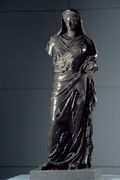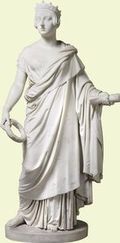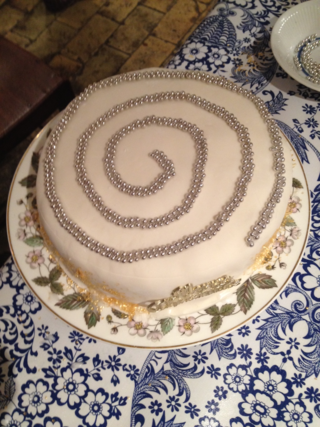Mary Beard's Blog, page 28
December 27, 2014
Old fashioned Christmas cooking
How do you cook a turkey? Ever since I have had any major role in the whole Christmas cookery process, I have cooked "the dinner" thanks to Katie Stewart's recipe in The Times Cook Book, c. 1972. The book is in truth a bit battered, and has so fallen apart in three different versions that it is honestly a bit hard to find the turkey cooking times, let alone the bread sauce recipe or the forcemeat stuffing. (That's the kitchen table above, plus an old Keith Floyd for the pudding recipe.)
I was a bit struck that a few years ago one of my friends remarked that this was a bit of a retro idea, but it wasn't until last Thursday that I saw quite how very old-fashioned dear Katie was.
As the daughter and I were getting it all together, she pointed out that we were very close to being candidates for some "recon" history programme, featuring the culinary habits of the early 1970s. For Katie, the cooking medium of choice was butter (olive oil hardly gets a mention), and almost every time she dares to suggest a herb, it is in some decidely un-fresh form (powdered sage in the stuffing is only the start). You can just hear the voice-over of the tv programme: "herbs were still uncommon in the post war British diet..."
As the daughter pointed out, if we were hip we wouldn't be cooking turkey (try goose, or some clever stuffed three bird combo, or just beef); and we certainly wouldn't be cooking it this way (ie lashings of butter and shove it in the oven at gas mark 3, end of). It would be all much more fresh and complicated.
This proved to be horribly true with a bit of research. My favourite recipe maker, Hugh Fearnley Whittingstall, insists that you can't cook the breast and legs of a turkey at the same heat and pace, so you have to deconstruct the damn bird even before you start. Jamie has you shoving mini rolls of pancetta into the poor thing's legs, or alternatively easing herb butter between the skin and the flesh (just try it!) and putting a clementine up its bum. Nigella, meanwhile, insists you give it a good soak for a start in a bucket of brine (the garden's a good place, but hello foxes...).
At this point, I thought "sod the dew picked sage", and all that. And sod the idea that you should cook the bird breast down, to keep her moist (I did fall for that once, and the thing appeared with a flat square breast). And sod all this time-consuming foody stuff. If Christmas Day is to be spent pushing pancetta rolls into the legs of dead birds, I really don't want to know. Talk about stressful. Katie knew that the cooks needed down-time to open their presents, have a few drinks, while the bird cooked effortlessly in the oven. And nice and moist it all is too, I can tell you, even without turning it upside down.
So I shall go on with Katie, till I fall off my perch. But meanwhile, I do have to confess that Hugh F-W's Thai soup recipe for the left overs is pretty amazing (substitute turkey for chicken), and -- yes -- I have just spent a long time cutting up the lemon grass and ginger..
Prententious, moi?
December 24, 2014
Happy Christmas...and first world problems
Happy Christmas all. The household, in a slightly tetchy mood I must confess, is moving to its big day, not without a few moral and political dilemmas.
I bought a couple of nice new decorations for the tree, including the Union Flag glittery specimen on the picture. I acquired it online late at night, and was instantly accused by the younger members of the family of having bought a UKIP ad. So, since when, I thought, had the Union Flag been owned by UKIP? But I carefully hung it next to the American Navy banner, and thought that they cancelled each other out.
The tree is, as it happens, where our first world problems began. That is to say, we discovered that the remote control for the Christmas tree lights (flex free) had run out of battery -- and this was not the size of battery sold in the local garage, or local Co-op or local wherever. Eventually the husband tracked one down in the city centre branch of Maplins. At this point, even the most ivory towered don begins to see a flash of light. 'Hang on', you say to yourself, 'we are scouring the town for a battery for the remote control on the elegant German, flex free tree lights, when there are people in supposedly leafy Cambridge who haven't got the cash to have a chicken for lunch, or presents for the kids.'
I'm trying not to be pious but it's not a circle that is easy to square.
There are all kinds of good things going on just nearby. Wintercomfort is relatively well known But I am told that at least one pub in Cambridge is having openhouse and free food for all comers on Christmas day. And I have tried to turn some of the spending patterns of the elite into a bit of a rule. To put it bluntly, if there is anyone in this country who spends more on Christmas drink than they give to charity, then they might find that a prompt to look at their priorities. Not a bad, bottom line, rule of thumb.
 Meanwhile our cake, hand made by yours truly, has been decorated by the daughter in a neat tribute to some Kenyan rock art (on the left). OK, I know what you are thinking ... just how pretentious and first world is that? A bloody Christmas cake doing its post colonial thing? But she has been working in Kenya and has just been to a cultural festival there which showcased the work of the African Rock Art Trust.
Meanwhile our cake, hand made by yours truly, has been decorated by the daughter in a neat tribute to some Kenyan rock art (on the left). OK, I know what you are thinking ... just how pretentious and first world is that? A bloody Christmas cake doing its post colonial thing? But she has been working in Kenya and has just been to a cultural festival there which showcased the work of the African Rock Art Trust.
If there is anything that this little cake on this little blog can do publicise that excellent group, then I'm OK
December 21, 2014
The REF post mortem -- and hype
I apologise to those reading this who don't give a toss about the Research Excellence Framework (though you can click on the link to find out more). This is a process which attempts to judge the research coming out of UK universities and to distribute money on that basis. It involves each member of "research active" staff submittig four"outputs" (ie books and articles) to be rated by a panel, plus an evaluation of the whole research "environment" and "impact". It is an extremely costly process of peer review and many of my friends and colleagues give up a lot of time to ensure that it is as fair as it can be. To be honest, I am grateful to them.
The results of this were just announced. I am not going to pretend that I am not pleased that my own faculty did very well. On most indicators, we at Cambridge were "top" of the Classics list . And, after you have put a whole load of work in, that is a relief -- at least until you reflect of how much research you could have done of you were not preparing the submission to the REF (for our chair I would estimate two articles, the rest of us one).
Maybe this (pseudo) transparency is all inevitable (though more vocal opposition to the "pseudo" might have been nice). What I can't stand is the bloody crowing once the results have come out.
There are, of course, all kinds of different ways of cutting the figures. Cambridge Classics comes out best if you count four star research outputs (very top ranking), St Andrews does better if you count four plus three star outputs together. That's a tribute to the subject as a whole I think (and to St Andrews).
But when you see the definition of four and three star outputs, your heart sinks. Four stars are "world leading" ouputs'; three stars are "internationally excellent". I am sure that the panels debated that division long and hard. But I challenge anyone to give me a clear idea of the difference.
Meanwhile, university PR departments have gone into overdrive to cut the figures to come out well for them and put them on their website. St Andrews Classics is admirably realistic and modest in saying that they came "second" (even though they could have made a case for "top" - RIGHT ON St Andrews). Other universities have not been so sensible. One London uni for example insists that its Classics department is 3rd in the country according to the "power metric". This is actually a really excellent place to study Classics, but the "power metric" involves multiplying the average score by the number of people in the department -- so any large institution will do well just on the multiplier. It is hardly meaningful, except to insist that it is big. If you take a look at this uni's website more generally, you will find the same trick has been played time and again. And where that wont work, you find headline claims like "100% of impact rated in international categories" in a subject that came in towards the bottom of the teens in national rankings.
At this point, I look as if I am taking these figures seriously. I hope I am not. I just wish that we would all stop bragging if we seem to have done well, that we would rein our press offices in, that we would think about how UK research was better collaborative than competitive -- and that we would stop trying to make everything into a PR headline. (On that score well done St Andrews, and -- dare I say it -- Cambridge.)
December 18, 2014
Saturnalian laughter
I have discovered a new role for myself over the last few years. I am the old lady who pops up at this time of year and says "gosh, did you know, the ancient Romans invented Christmas". I mean Sarturnalia.
I have just done this again, to great amusement all round (me especially), at a gig at the Bloomsbury Theatre. Robin Ince amd Tony Law had got a group of people together -- comics and others -- to celebrate an 'atheists'' (or at least 'non-Christian') Christmas, with historians; on Monday night, that was me and my mate Simon Goldhill (you see him above).
We were told thay we didn't need to pretend to be funny; that was someone else's job; we just had to go right on stage and do our stuff: *nervous moi? So I gave a spiel about what Romans did on Christmas Day (presents and getting pissed, basically + plus some drunken old men). And Simon gave a prequel of his new book (which touches on those weird early 20th century types who invented Nine Lessons from Kings -- not going to say more, you'll read soon).
I guess we were funny enough.
The truth was that the whole show was an eye opener for us academics. Of course we were way out of our depth. But it was good to watch the real comics in the dressing room, getting prepped for their performance.
To be honest, they seemed as anxious as we were (and they were obliged to make us laugh). If so i'm sure all will wirj out
December 14, 2014
Carols at King's
Today I was one of the lucky ones, as I got to go, with the husband, to the recording of "Carols from King's", which will be shown on BBC2 on Christmas Eve -- and which is quite like, but not identical to, the "Nine Lessons and Carols" broadcast live on the radio on the same day. (The schedules are here.)
I am not a paid up Anglican, but even stony hearted, irreligious me, finds this quite extraordinary -- both for the music and for the setting (which gets increasingly more "moody" as the lights go down (as above)).
On that setting, we had quite a few chats this afternoon about the Rubens' painting inserted above the Chapel altar in the early 70s, at the cost of considerable mucking around with the fabric - all vividly detailed in a chapter of Gavin Stamp's book Anti-Ugly.
The general consensus this afternoon among those I was talking to was that it actually looked pretty good, but that we would never have ripped out what had to be ripped out to put it in (and actually it was never ever a triptych so far as I know, as it pretends to be here).
Anyway, this was the sixtieth anniversary of the television broadcasts, so a bit special. And it will get a bit more razzmatazz in the schedules this Christmas, with a documentary on the whole tradition of the service, and a re-showing of the very first broadcast from 1954 (which must have appeared exactly a week before I was born, I ruefully reflected).
As for the line up, I dont think that it is breaking any confidences to say that this year the programme includes Stille Nacht sung in German next to a WW1 reading. That pleased me a lot because I have been doing quite a lot with the WW1 commemoration -- and because I have always found the carol singing from the trenches moving in ways than one.
First, how could you not be touched by that kind of Christmas truce (though I am still puzzled whether those football matches really did happen)? But second, how could you not be appalled by the fact that after that one day of carols those poor guys just got right back down to slaughtering each other. Does that make the "truce" (plus or minus footie) better or worse? I have to say I veer...
Those inevitably were my musings as I listened, along with all the usual puzzles about carols when you're actually reading the words. If anyone can explain to me how the "three ships' sail into Bethlehem, I'd be really grateful.
Bur, whatever, dont miss the tv feast of this over Christmas.
December 10, 2014
Book progress
I am now on chapters 6, 7 and 8 of my Roman history book. I say all three together, because they all deal with the late Republic, from the destruction of Carthage and Corinth in 146 BCE up to the assassination of Julius Caesar in 44 BCE.
I had been intending to explore it in just two chapters, but then it struck me that this period was the first time that we can get a really clear view of some real Romans in detail, and that I had to linger a little longer. So the idea is to call chapter 8 something like "A day in the life" and use that to think about some of those details of family, travel, housing, business, slaves, friendship, intellectual pleasures, art etc that you can extract out of (mainly) Cicero. It is still largely a toff's viewpoint, but it is so much more personally and deliciously detailed than anything available earlier, that it cant just be skipped over. There will be plenty of occasion towards the end of the book to try to see a bit more into lives of the "ordinary" people.
That means 6 and 7, without being drearily dry, will be covering politics (broadly defined) of the period.
It's hard to know how to do the Late Roman Republic in a fresh way. It's something I often teach, so have plenty up my sleeve to say. But having another look at the stuff in the last couple of weeks makes me think that I have been missing a trick. What has struck me is how smart some of these late Republican politicians were. OK I know that, with the benefit of hindsight, the whole system was going down the tubes. I know there were periods of murderous anarchy. I know that we are usually taught to deplore (or at least tut tut at) the disintegration of the political process. But equally there's some really splendid Roman analysis and attempts at reform on show.
What has struck me most is one of the areas of Roman political life usually most deplored: provincial government. Almost everything there is to read tells you that Roman rule overseas was more or less unbridled rapacity. So indeed some of it must have been. But there is another way to see it too. In the transition between an empire of conquest (smash and grab, without annexation) and an empire of government and territorial control -- that is between about the late third and early first centuries BCE -- Rome had to invent a system of imperial rule and provincial administration without any precedents or models to look to. What surprises me is not that some Roman governors in the first century BCE still operated with the old smash and grab conquest model of imperial rule and took all they could get, but that Rome had so quickly tried to establish a legal procedure for giving the provinicials redress in cases of extortion (even if its efficacy got undermined by internal political disputes), and that a sense of "proper" administration arose so quickly in response to exploitation and its discontents.
I was particularly struck by the Extortion Law of Gaius Gracchus in the 120s BCE (sorry I can find no easy link to the text or a discussion) which is almost certainly the law preserved on a bronze inscribed tablet known as the Tabula Bembina. It stretches to several pages in a modern printed text and it lays out procedures for prosecuting those Romans who have been on the take, down to precise instructions about how the final votes are to be cast (to ensure secrecy) and a rudimentary form of legal aid for the provincials trying to bring their case against the imperial power.
It gives a rather different view of the provincial process from the much more famous set of (largely undelivered) speeches of Cicero against Verres, which are somehow usually assumed to give a terrible but reasonably true glimpse of Roman conduct overseas -- and which I am minded to have a bit of a go at in the course of these chapters. What would the defence of Verres have looked like?
Dont worry, this isn't going to be a Niall Ferguson style of apologia for empire (if that's not being unfair to Ferguson...). But I do want to think a bit harder about what the invention of the Roman empire meant, about what it was they were inventing, with what aims and safeguards as well as failings.
December 5, 2014
How the Elgin Marbles nearly ruined my day
I think it is an absolutely great idea that the figure from the West Pediment of the Parthenon we generally know as "Ilissos" has gone on loan to The Hermitage (above). I say "we generally know as", because none of these pedimental pieces are named. This is pretty clearly a river god (what I mean is that it's like other "river gods"!) and we guess it's a local river, so maybe the Ilissos; but it's no more certain than that.
This seems to me a no brainer. Whatever Machiavellian schemes people have been trying to detect behind this loan, the idea that thousands of people in Russia who would have no chance of going to Greece or the UK will have a chance to enjoy this classical masterpiece is something to celebrate. I simply don't see that it has any impact either way on the claims to "repatriation", or is an insult to Greece. I hope that when the furore has died down the Greek authorities may also see (as I am sure some already do) that this is a great advert for ancient Greek culture and its values.
I am also unmoved by the idea that we should not be doing this while Russia is in the Ukraine. When governmental relations get frosty, it's all the more important to keep the cultural relations warm.
And whatever the outcome, or the pros and cons, there is a chance that all this coverage will attract more people to find out a bit more about the Parthenon and its pediments. (I may be uncharitable, but I suspect that some of the shouting today has come from those who havent a clue what the "Ilissos" is.)
Anyway, excellent a move as it seems to me, it came as a complete surprise. I had stayed in London last night, as I had meetings there on Thursday evening and Friday lunchtime, and the plan was to save the travel time between Cambridge and London and use the morning finishing Chapter 5 in my hotel bedroom, rather than on the train. In fact I was woken up before 8.00 by a phone call from a tv news show, asking me what I thought about the Elgin Marbles.
At that stage I didn't know what on earth they were talking about.
I soon did. And then the phone calls and texts and emails started. Having got the facts out, I made a brief comment to the Standard (conveniently by email, bless them-- it's half way down here, if you're interested); and began refusing the rest, or saying something as brief as I could get away with. Eventually I gave in to the young man who had woken me up (full marks for speed, I reckoned), and agreed to do an interview at 12.00 when I checked out of the hotel and before I went to my lunch date. That was a mistake as it turned out. First there was a phone call to say that they were held up in traffic and wouldn't be there till 12.15. They actually turned up at 12.30 and said it would take 15 - 20 minutes to set up. As I had to leave at 12.40, we just called it off, time wasted.
By the end of the day, I had poured cold water on the idea that there was a "gay" story in the "Ilissos" (it's the river along which in Plato's dialogue Socrates wanders with Phaedrus -- with all the homoeroticism that entailed -- but even so it might not be the Ilissos anyway). And I had agreed to talk to nice BBC Northern Ireland, provided I didn't actually have to go out of the house to a studio. I guess I had taken about 20 calls, texts etc.
Now I'm not really complaining. I mean I have written a book on the Parthenon, so it's quite reasonable to ask me to comment on this one. It's just that you dont realise quite how many people are out there who are after a few words. OK, you say, I could turn my phone off. True, but both my children are in corners of Africa and when they call, they often flash up on the phone (like most journalists do) as "unknown number". I'm not prepared to miss their calls, whatever the inconvenience.
Anyway, when the charming Rachel from LBC rang up, I sounded off in frustration "The Elgin Marbles have nearly ruined my day". You should write a piece on that, she replied. So here I have, Rachel.
(And if you want to know my view on the "repatriation" issue, I am still on the fence.)
December 3, 2014
Smart meter
The husband and I have been unusually compliant in having our old electric and gas meters replaced with a smart meter. You would have expected us to be part of the awkward squad on this one, but in fact when the letter from the energy company came, urging us to do this we rather meekly signed up to it.
A smart meter, for those who dont know, is a way of transmitting your energy use directly back to the company without the need for anyone to come to actually read the meter in your cupboard. (How many meter readers this will make redundant, I dont know. But when, with a flicker of subversion, I asked the last man to knock on the door before the smart installation if he was anxious, he replied rather brightly that the new meters were likely to break down so often that he wasnt honestly very concerned.)
The advantage for the consumer is supposed to be that you get a little screen (ours looks like the one above) that tells you exactly how much energy you are using at any moment, or any day, or week... The idea is that when you see how much your tumble dryer is actually costing, you wont use it so much. You'll save money -- and the planet at the same time. How green is that?
Well according to some things I've now been reading, not very green at all.
One big question turns out to be how much radiation these smart things emit. If you believe their critics (and I'm not sure I do), then it's more than the government is claiming. So the green benefit in cutting down on the tumble dryer (not in my case, because we dont have one) is more than cancelled out by poisoning the atmosphere in other ways.
And if that is an unnecessary worry, then there's the question of whether they (or their faulty installation) are liable to burn your house down; or if not that, if they will be an open door to hackers. Why should anyone want to hack into my electricity and gas meter? Well apparently, a clever hacker could simply turn everyone's power off, so creating mayhem. And that's not even thinking about those who could hack into their own meter to reduce the bills.
To be honest, I haven't been worrying too much on any such score. But spent the first week or so of smart meter ownership, turning the kettle or the electric fire or the lights on and off to see how much they cost. It was, I confess, entrancing for a bit, with all the obvious games... how could you get it all down to under 5p an hour? or how few machines did you have to turn on to get it up to over a quid?
But the novelty didn't last long. The truth is that you dont actually need a smart meter to tell you that the more heat something produces for longer, the more expensive it's going to be.
November 30, 2014
The best, least visited Roman Museum
I know that I have given the Centrale Montemartini Museum in Rome a little puff on this blog before. And indeed I try to give it puff whenever I can. But as I have spent most of my waking hours this weekend taking people round it (thanks to all groups!), I thought it probably deserved its own blog post, to itself.
The museum was founded in the late 1990's, when the Capitoline Museums were undergoing a major refit in preparation for the 2000 Jubilee. So some key works from the centre-city Museums were moved to a disused power station, down the Via Ostiense (go to Pyramide metro station and take a short bus ride, is the cheapest way to get there). It was an instant hit, partly because of the stunning juxtaposition of the machienery and the (largely) white marble sculpture. In a way it was the flavour of the moment of end of century museology (think Tate Modern and Musée D'Orsay), but this was a much braver version, because unlike the others they actually left a lot of the industrial machinery intact (it wasnt just using a power station as a shell).
The result is stunning as most people this weeked (not absolutely all, but most!) agreed. So when the main Capitoline Museums reopened, they kept Montemartini open too.
That's where the story gets a bit sadder.
Quite simply the popular success did not continue. And, unless I have visited on very inauspicious days, the number of visitors has shrunken to a handful. In fact some of the facilities there used to be have faded away. There's no bookshop any longer, and no café (and the 'no café' aspect probably exacerbates the downward spiral... most people like a museum to have a pit stop).
It's interesting to reflect on why this has happened (and it cant be just as simple as the fact that it is not in the tourist heart of the city). But for those who get there it is the most wonderful visit, with some of the best ancient sculpture (and a little painting) from Rome. I have just been writing about the scenes of  the Samnite Wars from a tomb on the Esquiline (probably mis third century BCE), and they are here (right). I reckon that these are probably the earliest western representation of real military conflict (ie not the Trojan War), to have survived.
the Samnite Wars from a tomb on the Esquiline (probably mis third century BCE), and they are here (right). I reckon that these are probably the earliest western representation of real military conflict (ie not the Trojan War), to have survived.
 And one of the most stunning pieces is the black basanite figure of Agrippina the Younger (Nero's mother), of which the real head has actually ended up in Copenhagen. She may well be from the Temple of Deified Emperor Claudius, and seen here as his priestess (whether one believes the story of the poisoned mushrooms or not).
And one of the most stunning pieces is the black basanite figure of Agrippina the Younger (Nero's mother), of which the real head has actually ended up in Copenhagen. She may well be from the Temple of Deified Emperor Claudius, and seen here as his priestess (whether one believes the story of the poisoned mushrooms or not).
That's just the start... dont miss any of it if you are in Rome.
November 27, 2014
The Romans at Buckingham Palace
Last night, we had a great time . . . at Buckingham Palace. No it's not one of my usual haunts, but I was getting an honorary degree from the University of London, and Princess Anne is the Chancellor, so on this occasion the University's Foundation Day was there. (Thank you all for a lovely time, and thank you John for a lovely speech.)
Anyway, there is one bit of the palace that made an impression from the very first time we went round with the kids, when it was newly open to the public. And that is a small room called the "Guard Room" at the top of the Grand Staircase. There are two amazing statues there -- of Victoria and Albert as Romans (not the ones at the top of this post -- these are variations on the same theme). And as we spotted last night there are some other Roman themes in that little room too.
 The most striking one is Albert as a Roman general, on the left. (It's hard to get images as you can't take pictures in the palace, and this is from the Royal Collections website. I confess.) It's by Emil Wolff. It wasn't from the sitter's point of view a huge success. It was probably an attempt to capture some sense of his formal destiny as consort, but it came across to him as a bit silly. In fact this is the slightly toned down second version, which gave him a longer tunic and some sandals, instead of the total bare legs and bare feet of the prototype. (When he tried to present the first version to Victoria, he had to confess that it was all a bit too undressed to actually put in a room.)
The most striking one is Albert as a Roman general, on the left. (It's hard to get images as you can't take pictures in the palace, and this is from the Royal Collections website. I confess.) It's by Emil Wolff. It wasn't from the sitter's point of view a huge success. It was probably an attempt to capture some sense of his formal destiny as consort, but it came across to him as a bit silly. In fact this is the slightly toned down second version, which gave him a longer tunic and some sandals, instead of the total bare legs and bare feet of the prototype. (When he tried to present the first version to Victoria, he had to confess that it was all a bit too undressed to actually put in a room.)
All the same I have quite a soft spot for it (and the incongruity of the head and body is no different from the incongruity in many Roman statues themselves). And it works much better than John Gibson's Victoria, also in Roman guise, of about the same date. The problem here is that (deities  apart) there really is no Roman iconographic tradition for a powerful woman. So there really is an odd mismatch here between the Roman matrona type and the little coronet on her head.
apart) there really is no Roman iconographic tradition for a powerful woman. So there really is an odd mismatch here between the Roman matrona type and the little coronet on her head.
What I hadn't spotted till last night (and I am afraid I have no pictures of these -- which presumably means I am not the only one to have passed them by) are two statues with a Pompeian theme. One is absolutely definitely a depiction of Nydia, the Blind Flower girl from The Last Days of Pompeii. It is not as good as the famous Randolph Rogers one (of which there are several versions in the USA), but it has a very similar hand gesture to the ear, and she is carrying a stick/oar (with which she is going to row the hero and heroine away from the conflagration??). The other I suspect to be that heroine, Iole. She has fewer identifying marks than Nydia, but she is clad as a Roman woman, and she carries what looks like a bible in her hand -- and the whole point about Glaucus (the hero) and Iole in the book is that they were Christians.
If I am right... I wonder if these both came originally from the Pompeian pavilion that Prince Albert had built in the palace gardens, and which was destroyed in the early twentieth century. If anyone could fill in, I'd be very grateful.
(By the way, both the Victoria and Albert statues were on show a few years ago in an exhibition at the Queen's Gallery and are in the catalogue with more info.)
Mary Beard's Blog
- Mary Beard's profile
- 4110 followers
















